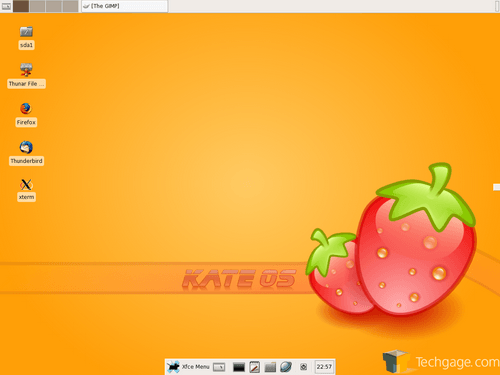- Qualcomm Launches Snapdragon 4 Gen 2 Mobile Platform
- AMD Launches Ryzen PRO 7000 Series Mobile & Desktop Platform
- Intel Launches Sleek Single-Slot Arc Pro A60 Workstation Graphics Card
- NVIDIA Announces Latest Ada Lovelace Additions: GeForce RTX 4060 Ti & RTX 4060
- Maxon Redshift With AMD Radeon GPU Rendering Support Now Available
Kate OS 3.0 Beta

Kate OS 3 is nearing it’s final stages, so I thought I would take a look at the recent beta. This is a lightweight distro with the goals of providing what you need to get a great system up and running, and also the security and efficiency you need.
Page 1 – Introduction
Though I am unsure when the project began, Kate OS has been around for a little while. 2.0 was released early last year and was well received. Fast forward more than a year later, and we see 3.0 final on the horizon. Kate OS is a Polish lightweight distribution for Linux users who want control over their system and want access to some great functionality. The lightweight part is evidenced by Xfce4 being the default desktop environment.
The developers behind Kate are noticeably passionate about what they do, and are huge free software buffs. The premise behind the OS is to have a secure and efficient system, being able to do the normal everyday things you love while running a completely cost-free OS.
I have in the past meant to check Kate OS out, but never found the time. A recent quick look in DistroWatch piqued my interest, so I had to give it a go. The default theme for the system is colorful, which I am not usually a fan of, but it caught my eye. What also grabbed me were the clear goals of the developers. They know what they want from their Linux, and pursue those ideas until they get done. Kate is designed to function well on even a small machine, but can be scaled up to take full advantage of your beefy system. The OS is designed to be secure, so they chose to use the proven PAM authorization system.
They encourage use of GTK+ in order to keep things compatible. You want to be able to install Kate OS and play music and use GTK+ reliant programs, so this saves some hassle. Earlier versions of Kate OS were based on Slackware, as so many other distros are, but are not so anymore. They are built from scratch on top of the kernel, with all the necessary goodies thrown in. So… time to install.
After you boot with the install CD, you will find yourself staring as massive text saying something like, “KATE III BETA”. It’s a straight forward greeting if I’ve ever seen one! If you have a clean hard drive and don’t need to worry about a Windows install, this will be simple. If you are dual-booting, then you just have to understand partitions and how to use fdisk. If the drive is completely clean, you will need to create a swap and root partition, and any others that you may need.
The entire install process is done through a DOS-style install. It’s not pretty, but it works. After you create the partitions and are ready to go, the setup program will give you the option to set the swap partition active, and also create the root directory on the other partition. Then comes the software selection. Right off the bat there are around 15 options, and by default only 14 are checked. If you have patience, you can go through all of the menus and customize your install to your liking. I took the easy route though and just chose the full install, which ends up being around 4GB. A heavyweight install, for a lightweight distro ;)
After the software is installed, which took no time at all, you will have the option to manually configure initrd or have it done for you. For simples sake, I took the latter route. Then you can configure LILO and choose where you would like to install it. I found it odd that I didn’t have an option for a GRUB installer, even though I selected it from the software package list. Regardless, LILO functions well enough for now.
There are a few different window managers that you can choose from, the default being of course Xfce4. You can also choose from Fluxbox and WindowMaker, upon a few others. You will not have the option here to install KDE or GNOME, but can use the updateos to do so after the system is installed. Creating the users was also proven extremely easy, especially since the setup automatically adds the user to a pre-selected list of groups. You can of course edit these groups to your liking.
Overall, the installation was straightforward, but will not likely be if you have never used Linux before. With a little reading, you should have no problem, but you should know at least the basics before you jump in here. If you are interested in giving the version we are looking at a try, but don’t want to install it, you will be happy to know that they have recently released a Live CD version on their website.
Support our efforts! With ad revenue at an all-time low for written websites, we're relying more than ever on reader support to help us continue putting so much effort into this type of content. You can support us by becoming a Patron, or by using our Amazon shopping affiliate links listed through our articles. Thanks for your support!






